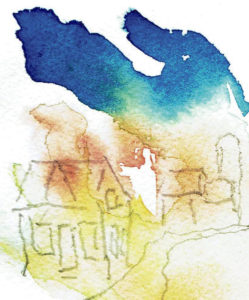Columnists
Alcea rosea

Mrs. Jones was a lady who once lived in the house across the road. Her years spent there were before my arrival in the County. I never did get a first name. “That house? The ol’Jones place? She lived alone”, was the closest I got from the neighbours. I promised myself to research it one day. While the old house still stands, it’s slowly losing its dignity from years of weathering. The raccoons are the only occupants these days.
One of the small deciphering details I gathered about Mrs. Jones is that she liked hollyhocks. The first spring I was here the flowers formed a shower of colour across the front of the house, like a serenade to her. I mean, now and then it’s a thing to drive by abandoned houses along a side road and witness how the lilac or the peonies or the mulberry bushes have taken over, right? I figure it’s because they are a living thing and they blossom as a reminder of the seasons of hands in the soil, dirt under fingernails, the stiffness of bent knees, which were uplifted each spring with the fruits of their efforts. Daisies or wild roses set in a vase on a kitchen table could be there to light up a room.
 Mrs. Jones’ hollyhocks were a subject for many of my drawings back then. The shadows of the ghost house formed a backdrop. Eventually I noticed how the autumn winds had carried seeds across the road and over to my place. Hollyhocks began to appear in springtime and I was glad for it. But every spring I noticed how the flowers seemed to move positions, seemed to be on the march towards the sunrise, slowly travelling across the yard. Gradually the home seedbed over at Mrs. Jones’ died away and the remnant plants growing in my yard were all that remained. It has been two years now that they haven’t returned; they apparently vanished into the ethers, to join the soul of Mrs. Jones.
Mrs. Jones’ hollyhocks were a subject for many of my drawings back then. The shadows of the ghost house formed a backdrop. Eventually I noticed how the autumn winds had carried seeds across the road and over to my place. Hollyhocks began to appear in springtime and I was glad for it. But every spring I noticed how the flowers seemed to move positions, seemed to be on the march towards the sunrise, slowly travelling across the yard. Gradually the home seedbed over at Mrs. Jones’ died away and the remnant plants growing in my yard were all that remained. It has been two years now that they haven’t returned; they apparently vanished into the ethers, to join the soul of Mrs. Jones.
I was hoping it was just a blip in the germination pattern of hollyhocks that had occurred and that, like a sailing ship, they would one day return. Until I read up on them. Well, the colours we already know about, bunches of hollyhocks stand tall and smiling in the gardens like the Van Grootheest’s on the back road of Bloomfield. But I see where they are a shortlived perennial—and talk about travel! Whew! It’s told that they arrived in Europe in the latter 1500s by way of the Holy Land, the ‘holy’ plants having been first transplanted from China. Las Varas de San Jose—the staff of St. Joseph—was the Spanish name for the flower that found its way into many early paintings in Southern Europe.
Come 1800s, the rage in Europe was ornate gardening, glasshouses and capitalist-driven propagation: Pteridomania or Fern-Fever; orchid madness; the tulip craze was happening and behold the hollyhock was developed into more varieties than the mind could imagine. Arriving to North America with the colony ships, its cultural roots (pardon the pun) held home-country memories for many of the newly landed.
The dried flower can be made into tea, natural remedies and dye that, with the addition of a fixative, produce yellow regardless of the colour of the flower. I even once had the flower added to a salad—can you imagine?
So, as I write this, beside my keyboard sits a medium size zip-lock bag chock-a-bloc with—you guessed it: hollyhock seed! I figure it’s probably due to my habit of repeating Mrs. Jones’ story that someone wanted to get the subject changed so left these at my doorstep as a hint to move on to another day.
Now, to decide how and when to plant? The main thing is sunlight I’m told. And surely if they can thrive in arid New Mexico, Hillier clay can’t be a problem. See, this is when the obsessive compulsive part of me takes over. Will they be as nice as the Van Grootheest’s? I wonder if some of my new crop of hollyhocks will find their way back across the road to Mrs. Jones’ old house and replenish her front garden? Hell, if they made it all the way from China, across the road is a piece of cake. They’ve done it once already! I’ll keep you posted on that one.

Comments (0)